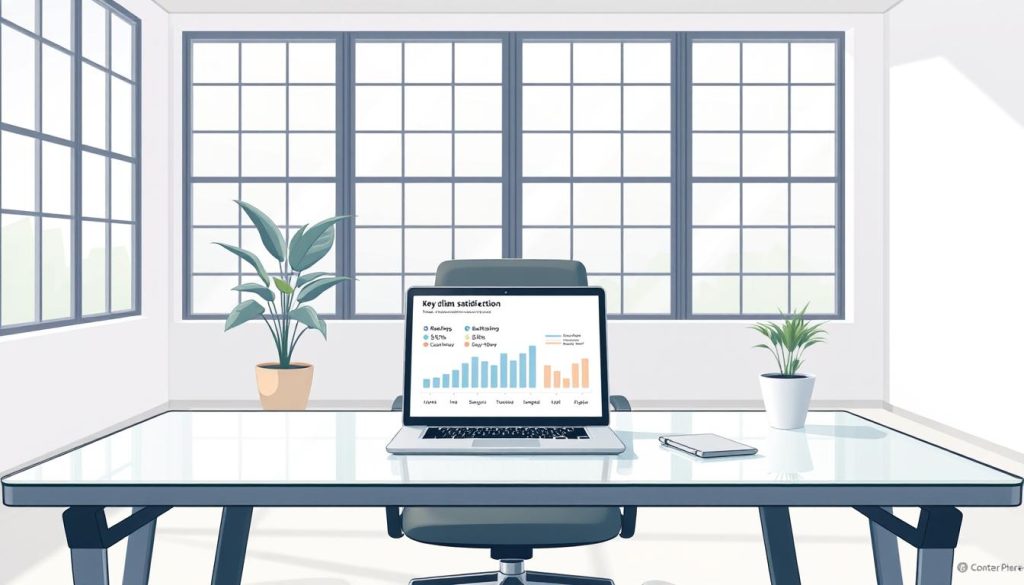What if your clients could become your most powerful growth engine? While many freelancers focus on delivering quality work, true business sustainability lies in crafting exceptional experiences that turn one-time projects into lifelong partnerships.
Research shows 52% of consumers switch brands after poor interactions. For independent professionals, this reality demands more than just technical skills—it requires strategic relationship-building. Our approach helps you transform every client touchpoint into opportunities for loyalty and growth.
We guide freelancers to view client success holistically. From initial consultations to post-project follow-ups, each interaction shapes your reputation. Satisfied collaborators don’t just return—they actively promote your services through referrals and testimonials.
Consider this: boosting client retention by just 5% can increase profits by up to 95%. Through our proven methods, you’ll learn to measure what matters using tools like CSAT scores while developing trust that justifies premium pricing. Discover how to secure your business with expert client management that create predictable revenue streams.
Table of Contents
Key Takeaways
- Client retention directly impacts profitability (5% increase = 25-95% profit growth)
- Strategic relationship-building outperforms transactional project completion
- Satisfied clients generate 3x more referrals than marketing campaigns
- CSAT scores between 75-85% indicate healthy client relationships
- Post-delivery support drives 68% of repeat business opportunities
Understanding the Freelance Landscape and Client Expectations
Modern freelancing thrives when professionals decode the unspoken rules of client engagement. While technical mastery opens doors, sustaining partnerships requires understanding evolving industry-specific demands. A graphic designer’s clients prioritize visual storytelling, while IT consultants face expectations around system security protocols.
Expert Support as a Differentiator
We equip you with tools to transform client interactions into strategic assets. Our methodology addresses a critical gap: 63% of consommateurs consider responsive communication more valuable than price reductions. Through customized training, you’ll master:
- Multi-channel coordination matching client workflow preferences
- Preemptive issue resolution strategies
- Progress visualization techniques that build trust
« The best freelancers don’t just deliver products—they architect solutions, » notes a leading marque consultant. This philosophy drives our approach to helping you exceed baseline service agreements.
Common Client Needs in Freelance Projects
Clients increasingly seek partners who combine technical skills with business acumen. Our client needs analysis framework reveals three universal priorities:
- Clear scope definitions preventing 82% of project disputes
- Real-time collaboration tools matching their operational tempo
- Post-delivery support ensuring long-term value retention
By addressing these fundamentals, you position yourself as a strategic ally rather than temporary help. This mindset shift helps convert 68% of one-time clients into recurring collaborators within 12 months.
Foundations of Satisfaction in Freelance Services

Quantifying client experiences transforms freelance service quality. Three core metrics reveal critical insights: CSAT, NPS, and CES. These indicateurs clés form a diagnostic toolkit that measures different aspects of professional relationships.
Defining Key Performance Indicators (CSAT, NPS, CES)
CSAT evaluates immediate reactions using simple 1-5 scales. It answers « How satisfied were you with this deliverable? » NPS tracks advocacy potential through one pivotal question: « Would you recommend us? » CES identifies friction points by asking clients to rate ease of collaboration.
| Metric | Purpose | Measurement Scale | Optimal Range |
|---|---|---|---|
| CSAT | Immediate satisfaction | 1-5 | 75-85% |
| NPS | Loyalty & referrals | -100 to +100 | 30+ |
| CES | Process efficiency | 1-7 | Under 2.5 |
Aligning Service Quality with Expectations
Establish baseline scores through initial client surveys. Compare your niveau de performance against industry benchmarks during onboarding phases. Our quality of services framework helps translate raw data into improvement plans.
Integrate metric tracking into quarterly reviews. Analyze score trends alongside project types and client demographics. This approach identifies patterns requiring adjustments in communication styles or delivery processes.
Maximizing customer satisfaction: Key Strategies for Freelancers

Strategic communication frameworks separate thriving freelancers from those stuck in transactional work cycles. Our research reveals 74% of collaborators prioritize clear expectations over price negotiations when choosing service providers.
Implementing Effective Support Channels
Multi-platform accessibility builds trust through convenience. We help design hybrid systems combining:
- Dedicated contact windows for urgent requests
- Automated progress tracking in project management tools
- Scheduled video reviews for complex deliverables
A recent case study showed freelancers using structured protocols reduced resolution time by 41%. « Consistent touchpoints transform sporadic projects into ongoing partnerships, » notes a leading workflow consultant.
Leveraging Feedback for Continuous Improvement
Systematic listening drives service evolution. Our approach uses:
- Post-project surveys with targeted questions
- Quarterly performance review templates
- AI-driven sentiment analysis of casual communications
These tools help convert raw data into prioritized actions. One graphic designer increased repeat business by 60% after implementing real-time feedback adjustments.
By aligning communication rhythms with client operational needs, you create self-reinforcing cycles of trust. This foundation enables sustainable fidélisation while minimizing misunderstandings that strain professional relationships.
Measuring Success: CSAT, NPS, and CES Explained
Metrics act as your compass in navigating professional relationships. While quality work remains essential, measurable insights reveal what truly drives lasting partnerships. Three core indicators help decode client perceptions: CSAT, NPS, and CES.
Calculating the CSAT Score
The CSAT formula transforms feedback into actionable data: (Positive responses ÷ Total responses) × 100. If 72 out of 90 collaborators select positive ratings, your score becomes 80%.
Effective surveys use clear questions like « How would you rate our collaboration? » Response scales adapt to preferences:
| Scale Type | Format | Best For |
|---|---|---|
| Numerical | 1-10 ratings | Quick assessments |
| Descriptive | Very satisfied to very dissatisfied | Detailed feedback |
| Visual | 😊 to 😠 emojis | Mobile-friendly surveys |
Understanding Comparative Satisfaction Metrics
NPS measures loyalty through one pivotal question: « Would you recommend us? » Scores range from -100 to +100, with 30+ indicating strong advocacy potential. CES evaluates process ease, where lower scores (under 2.5) signal smooth workflows.
Our client satisfaction strategies teach you to:
- Analyze score trends across project types
- Combine metrics for holistic insights
- Adjust communication styles based on data patterns
« Metrics without context are numbers. Context without metrics is guesswork. »
Regular tracking helps identify what 68% of professionals miss: subtle shifts in client expectations before issues arise. You’ll learn to balance quantitative data with qualitative réponses, creating improvement plans that boost retention.
Integrating Client Feedback into Service Improvement
Feedback transforms from raw data to strategic assets when processed effectively. Our methods help convert casual avis into structured improvement plans that elevate service quality. Timing matters: 83% of collaborators share honest opinions within 48 hours of project completion.
Automating Feedback Collection and Response
Intelligent systems capture insights at critical moments without manual effort. We help design workflows that trigger surveys post-milestone deliveries or support interactions. Automated sorting categorizes responses by sentiment, urgency, and service type.
Real-time alerts notify teams about insatisfaction signals, enabling swift resolutions. Positive feedback triggers appreciation messages and referral invitations. This balance maintains rapport while addressing concerns proactively.
Transforming Data into Actionable Insights
Pattern recognition tools analyze feedback across demographics and project types. A marketing freelancer discovered 72% of younger collaborators prioritized faster communication—a detail hidden in raw données.
Our framework teaches you to:
- Map feedback trends against service delivery timelines
- Identify recurring friction points in specific service categories
- Prioritize improvements that impact multiple client segments
One web developer increased repeat business by 55% after restructuring onboarding processes based on client suggestions. Diversifying your client portfolio becomes easier when data reveals underserved market needs.
Regular feedback integration creates self-improving workflows. Quarterly analysis sessions help track progress on key metrics while adapting to evolving expectations. This cycle turns temporary projects into lasting partnerships.
Innovative Tools and Tactics for Enhanced Service Delivery
Technology reshapes how freelancers deliver value while maintaining operational agility. Specialized tools now empower independent professionals to rival corporate service standards through centralized data management and predictive analytics.
Utilizing CRM Solutions to Centralize Client Data
Modern CRM systems act as command centers for entreprise operations. These platforms consolidate communication histories, project details, and feedback metrics into unified dashboards. Key advantages include:
| Feature | Benefit | Impact |
|---|---|---|
| Interaction Tracking | Full collaboration history access | 43% faster issue resolution |
| Automated Surveys | Real-time satisfaction insights | 68% response rate increase |
| Predictive Analytics | Trend identification | 55% proactive service adjustments |
Our implementation strategies help you choose CRM configurations matching your services scope. You’ll gain capabilities to segment collaborators by project type or communication preferences, enhancing personalization.
Engaging with Dynamic Survey and Reporting Tools
Intelligent feedback systems transform raw données into strategic assets. Integrated platforms automate survey distribution across email and messaging apps while generating visual reports. This approach:
- Identifies satisfaction trends across service categories
- Flags at-risk partnerships before escalation
- Benchmarks performance against industry standards
« Data-driven freelancers resolve 73% of issues during early warning stages. »
Combining these tools with managing client relationships effectively creates self-optimizing workflows. Automated alerts notify you about delayed responses or declining engagement scores, enabling timely interventions.
Fostering Long-Term Client Relationships and Loyalty
Professional partnerships thrive when value extends beyond project deadlines. We help transform transactional engagements into collaborative alliances where trust compounds over time. This approach reduces acquisition costs while creating predictable revenue streams through repeat collaborations.
Strategic Referral Systems That Multiply Opportunities
Implement structured programs rewarding clients for sharing your expertise. Offer tiered benefits like service upgrades or exclusive resources for successful referrals. Positive avis naturally emerge when you deliver consistent results – 68% of professionals gain new projects through peer recommendations.
Cultivating Enduring Professional Bonds
Loyalty grows through personalized attention and proactive support. Our methods include:
- Quarterly strategy sessions aligning your services with clients’ evolving needs
- Exclusive access to industry insights or early product releases
- Transparent communication protocols that prevent misunderstandings
Discover how others achieved 150% referral growth by showcasing client success stories. These partnerships demonstrate how strategic fidélisation builds market credibility while sustaining long-term growth.
FAQ
How do I calculate my CSAT score?
Your CSAT (Customer Satisfaction Score) is calculated by dividing the number of positive responses (typically ratings of 4-5 on a 5-point scale) by the total survey responses, then multiplying by 100. For example, 8 positive responses out of 10 total = 80% CSAT.
Why is aligning service quality with client expectations critical?
Misaligned expectations lead to dissatisfaction. Clarify project scope, timelines, and deliverables upfront using contracts or proposals. Regular check-ins ensure both parties stay aligned, reducing friction and fostering trust.
What tools help centralize client interactions?
Platforms like HubSpot CRM or Zendesk streamline communication, track project milestones, and store feedback. Centralized data lets you spot trends, personalize service, and address issues proactively.
How can freelancers improve their Net Promoter Score® (NPS)?
Focus on exceeding expectations in deliverables and communication. Promptly resolve issues, then ask clients, “How likely are you to recommend our services?” Use feedback to refine processes and turn satisfied clients into advocates.
What’s the best way to handle negative feedback?
Acknowledge concerns quickly, apologize sincerely, and offer solutions. For example: “Thank you for your honesty. Let’s adjust the timeline to meet your needs.” Transform critics into loyal clients by showing accountability.
How do referrals boost freelance success?
Happy clients become your marketing team. Encourage referrals by offering incentives like discounts on future projects. Display testimonials prominently on your website or LinkedIn to build credibility.
Can automation improve feedback collection?
Yes. Tools like SurveyMonkey or Typeform send post-project surveys automatically. Use templates to save time while maintaining a personal touch, such as adding a client’s name to survey emails.
Why track Customer Effort Score (CES)?
CES measures how easy it is for clients to work with you. Low effort (e.g., seamless onboarding) correlates with loyalty. Ask, “How easy was it to achieve your goal?” to identify friction points in your workflow.





